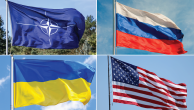China, Russia and the U.S. are the countries most widely viewed as international threats across 25 nations surveyed. In fact, one of these countries appears in the top three most common responses from every nation included in our survey, except Israel. Still, sizable shares in some places say there is no country that poses the greatest threat to their own.
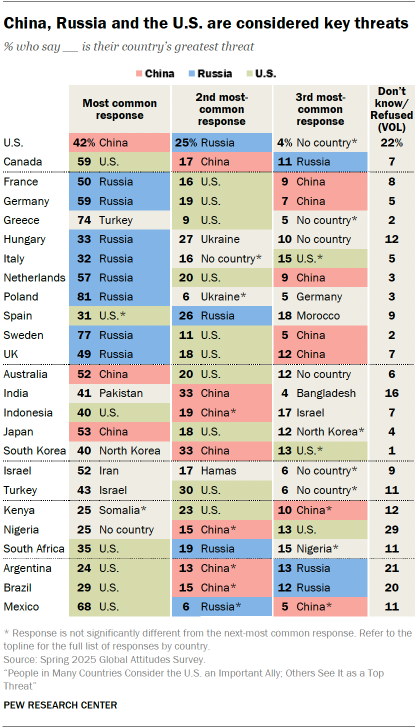
In the U.S., people most often point to China as their country’s greatest threat, followed by Russia. In Canada, however, a majority say their top threat is the U.S., with smaller shares naming China and Russia. Canada is one of several nations where the U.S. is considered both a top threat and a top ally.
Across Europe, respondents most consistently say Russia poses the greatest threat to their country. Notably, three-quarters of adults or more in Poland and Sweden take this stance.
The shares naming Russia as a threat in Europe today are much larger than when we asked a similar question in 2007 in a subset of these countries. In the UK, for example, people at that time were more likely to name Iran, Iraq, China and the U.S. as threats. Fewer than 10% of Britons saw Russia as a significant threat, compared with 49% today.
The U.S. is also seen as a threat across Europe. It is the second-most common response in six of the 10 European countries surveyed, and tied with Russia at the top in Spain. China is the third-most common answer in five European countries.
Greece is the only European country where fewer than a quarter of adults name Russia as their country’s greatest threat; a 74% majority name Turkey. In Hungary and Poland, the U.S. does not appear among the top three responses. Instead, Ukraine emerges as the second-most common threat in Hungary (27%) and ties for second in Poland (6%).
In the Asia-Pacific, China looms large. It is the most common or second-most common response in all five nations surveyed in that region, and tops the list in some places by quite a wide margin: Roughly half of adults in Australia and Japan say China is the greatest threat to their country, followed by about two-in-ten who name the U.S.
In the case of India and South Korea, proximity and historical conflict seem to shape respondents’ views. In India, 41% of adults say Pakistan poses the most significant threat to their country. Another third say China – the next-most common response. (The India survey was conducted Feb. 7-April 21, 2025, before the recent deadly conflict between India and Pakistan.)
Meanwhile, South Koreans most frequently name North Korea as the greatest threat to their country, at 40%.
In Israel, about half of people say Iran is their greatest threat, followed by 17% who say Hamas. Turks, on the other hand, most commonly name Israel (43%), followed by the U.S. (30%).
In sub-Saharan Africa, the U.S. is commonly seen as a significant threat: 35% of South Africans, 23% of Kenyans and 13% of Nigerians take this stance. Another quarter of Kenyans say neighboring Somalia is their country’s greatest threat (not statistically different from the share who name the U.S.). The most common response among Nigerians, given by 25%, is that no country is their greatest threat.
In each of the three Latin American countries surveyed, the U.S. is the most common response. Mexicans are especially likely to say the U.S. poses the greatest threat to their country, with 68% holding this view.
Views by ideology
In about half of the countries surveyed, those who place themselves on the left are more likely than those on the right to say the U.S. is their country’s greatest threat. For example, 34% of Australians on the left name the U.S., compared with 18% in the center and 5% on the right.
In nine countries, those on the right are more likely than those on the left to say China is their country’s greatest threat.
Views of these countries as economic, national security threats
After respondents named the country they think poses the greatest threat to their own, we asked them to rate how much of an economic threat and national security threat that country is. Overall, the U.S. is seen mostly as an economic threat, while Russia is seen mostly as a security threat.
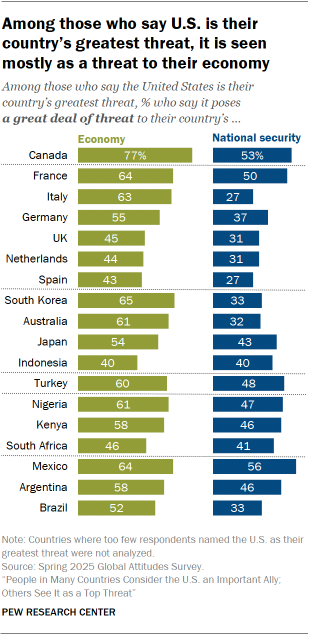
U.S. as an economic threat
Those who say the U.S. is the greatest threat to their country are generally more likely to view it as an economic threat than a national security concern.
In Canada, roughly three-quarters of adults who name the U.S. say it poses a great deal of threat to their economy. Majorities in Argentina, Australia, France, Germany, Italy, Kenya, Mexico, Nigeria, South Korea and Turkey agree.
People who see the U.S. as a threat are less likely to label it a security threat in most countries surveyed. Still, half or more in Mexico (56%), Canada (53%) and France (50%) say it poses a great deal of threat to their national security.
Russia as a national security threat
Among those who say Russia is the greatest threat to their country, more believe it threatens their national security than their economy.
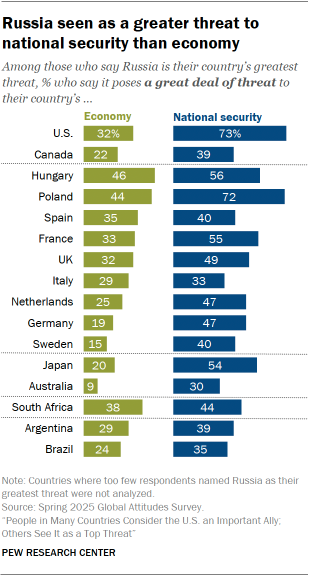
For example, 73% of Americans who see Russia as their top threat say it poses a great deal of security risk, while 32% say this about economic risk.
In Europe, at least a third of people who name Russia see it as a significant security threat. This share comes to roughly half or more in France, Germany, Hungary, the Netherlands, Poland and the UK. In these countries, significantly smaller shares view Russia as an economic threat.
Views of China’s impact are more mixed
In some countries, assessments of China as an economic and security threat don’t lean one way or the other. For example, 50% of Australians who see China as their greatest threat say it poses a great deal of economic threat, while an identical 50% say it’s a significant national security threat.
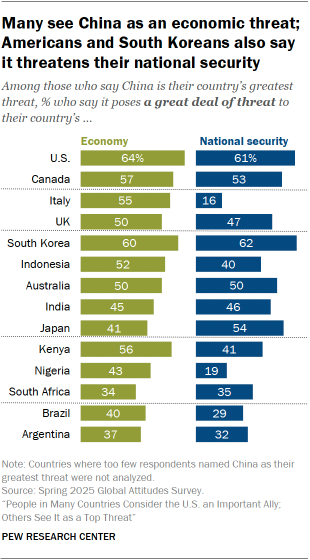
People in the U.S. are also about equally likely to label China as an economic threat (64%) and a security threat (61%). The pattern in South Korea is the same.
However, Italians and Nigerians who name China are more likely to say it threatens their economy than their national security.
Japan is the only country where people are more likely to see China as a security threat than an economic one (54% vs. 41%).



